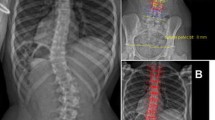Abstract
Study Design
Prospective.
Objective
To evaluate the reliability of three-dimensional (3D) spinal models from Micro Dose EOS x-rays compared to standard, Low Dose EOS x-rays utilized for evaluating patients with adolescent idiopathic scoliosis (AIS).
Summary of Background Data
There is a strong suggestion that radiation exposure to scoliosis patients can be further reduced.
Methods
Sixty AIS patients who received biplanar, posteroanterior, and lateral standard Low Dose spine x-rays in our EOS imaging unit (∼0.33 mGy) as part of routine care also underwent an additional set of new reduced “Micro Dose” EOS x-rays (∼0.05 mGy) using a recently developed protocol. Two measurers created 3D models of the images using sterEOS software (Low Dose x2, Micro Dose x2). From this 3D modeling software, coronal Cobb angles, sagittal (T1–T12, T4–T12, L1–L5, L1–S1), and apical axial rotation measurements were obtained. Intraclass correlations (ICCs) and standard error of measurement (upper bound of 95% confidence interval) for the differences between Low Dose and Micro Dose measurements were compared. Interrater reliability was assessed on standard two-dimensional (2D) radiographic measurements.
Results
The ICCs were rated as “substantial” to “almost perfect” for Low Dose 3D, Micro Dose 3D, and 2D measures (range 0.78–0.99). The calculated measurement error was not significantly different between groups except for intrarater error on 3D L1–L5 lordosis (2.9° Micro Dose vs. 2.2°, p =.04), interrater 3D rotation of the lumbar apex (2.6° Micro Dose vs. 1.7°, p =.03), and 2D T12–sacrum lordosis (4.6° Micro Dose vs. 3.4°, p =.04).
Conclusions
Although statistically significant differences in average measurement error were observed in lordosis and lumbar apex rotation, these differences are not believed to be clinically significant. The Micro Dose images have slightly less clarity qualitatively, yet the critical 2D and 3D measures of the curvature were reliably measured with error of measurement comparable to standard radiologic techniques.
Level of Evidence
Level I, Diagnostic.
Similar content being viewed by others
References
Brenner DJ, Doll R, Goodhead DT, et al. Cancer risks attributable to low doses of ionizing radiation: assessing what we really know. Proc Natl Acad Sci U S A 2003;100:13761–6.
Kleinerman RA. Cancer risks following diagnostic and therapeutic radiation exposure in children. Pediatr Radiol 2006;36(suppl 2):121–5.
Strauss KJ, Kaste SC. The ALARA concept in pediatric interventional and fluoroscopic imaging: striving to keep radiation doses as low as possible during fluoroscopy of pediatric patients—a white paper executive summary. AJR Am J Roentgenol 2006;187:818–9.
Deschenes S, Charron G, Beaudoin G, et al. Diagnostic imaging of spinal deformities: reducing patients radiation dose with a new slot-scanning X-ray imager. Spine (Phila Pa 1976) 2010;35:989–94.
Glaser DA, Doan J, Newton PO. Comparison of 3-dimensional spinal reconstruction accuracy: biplanar radiographs with EOS versus computed tomography. Spine (Phila Pa 1976) 2012;37:1391–7.
Landis JR, Koch GG. The measurement of observer agreement for categorical data. Biometrics 1977;33:159–74.
Presciutti SM, Karukanda T, Lee M. Management decisions for adolescent idiopathic scoliosis significantly affect patient radiation exposure. Spine J 2014;14:1984–90.
Pace N, Ricci L, Negrini S. A comparison approach to explain risks related to X-ray imaging for scoliosis, 2012 SOSORT award winner. Scoliosis 2013;8:11.
Bone CM, Hsieh GH. The risk of carcinogenesis from radiographs to pediatric orthopaedic patients. J Pediatr Orthop 2000;20:251–4.
Despres P, Beaudoin G, Gravel P, et al. Physical characteristics of a low-dose gas microstrip detector for orthopedic x-ray imaging. Med Phys 2005;32:1193–204.
Gogos KA, Yakoumakis EN, Tsalafoutas IA, et al. Radiation dose considerations in common paediatric X-ray examinations. Pediatr Radiol 2003;33:236–40.
Luo TD, Stans AA, Schueler BA, et al. Cumulative radiation exposure with EOS imaging compared with standard spine radiographs. Spine Deform 2015;3:144–50.
Vano E, Fernandez JM, Ten JI, et al. Transition from screen-film to digital radiography: evolution of patient radiation doses at projection radiography. Radiology 2007;243:461–6.
Carreau JH, Bastrom T, Petcharaporn M, et al. Computer-generated, three-dimensional spine model from biplanar radiographs: a validity study in idiopathic scoliosis curves greater than 50 degrees. Spine Deform 2014;2:81–8.
Kuklo TR, Potter BK, O’Brien MF, et al. Reliability analysis for digital adolescent idiopathic scoliosis measurements. J Spinal Disord Tech 2005;18:152–9.
Faria R, McKenna C, Wade R, et al. The EOS 2D/3D X-ray imaging system: a cost-effectiveness analysis quantifying the health benefits from reduced radiation exposure. Eur J Radiol 2013;82:e342–9.
Dietrich TJ, Pfirrmann CW, Schwab A, et al. Comparison of radiation dose, workflow, patient comfort and financial break-even of standard digital radiography and a novel biplanar low-dose X-ray system for upright full-length lower limb and whole spine radiography. Skeletal Radiol 2013;42:959–67.
Author information
Authors and Affiliations
Corresponding author
Additional information
This study was conducted at Rady Children’s Hospital, San Diego, CA.
Author disclosures
PON (grants from EOS Imaging, during the conduct of the study; grants and other from POSNA, grants and other from Setting Scoliosis Straight Foundation, other from Rady Children’s Specialists, grants and personal fees from DePuy Synthes Spine, personal fees from Norcal, personal fees from Law firm of Carroll, Kelly, Trotter, Franzen & McKenna, personal fees from Law firm of Smith, Haughey, Rice & Roegge, grants from NIH, grants from OREF, grants and other from SRS, grants from EOS imaging, personal fees from Thieme Publishing, other from NuVasive, personal fees from Ethicon Endosurgery, other from Electocore, personal fees from Cubist, other from International Orthopedic Think Tank, other from Orthopediatrics Institutional Support, outside the submitted work; In addition, Dr. Newton has a patent Anchoring Systems and Methods for correcting Spinal Deformities (8540754) with royalties paid to DePuy Synthes Spine, a patent Low Profile Spinal Tethering Systems (8123749) issued to DePuy Spine, Inc, a patent Screw Placement Guide (7981117) issued to DePuy Spine, Inc, and a patent Compressor for Use in Minimally Invasive Surgery (7189244) issued to DePuy Spine, Inc), YK (grants from EOS Imaging, during the conduct of the study), CEB (grants from EOS Imaging, during the conduct of the study), FGR (grants from EOS Imaging, during the conduct of the study), TPB (grants from EOS Imaging, during the conduct of the study), BY (reports grants from EOS Imaging, during the conduct of the study; grants and personal fees from K2M, grants and personal fees from Depuy Synthes Spine, personal fees from Medtronic, personal fees from Nuvasive, grants from KCI, grants from POSNA, personal fees from Orthopediatrics, grants and personal fees from Ellipse, personal fees from Globus, outside the submitted work; in addition, BY has a patent Adjustable Axial Spinal Rod Connector (20140066989) issued to K2M, and a patent Flexible Fastening System (20140257397) issued to K2M).
IRB approval was obtained for this study.
This study was supported by a grant from EOS Imaging.
Rights and permissions
About this article
Cite this article
Newton, P.O., Khandwala, Y., Bartley, C.E. et al. New EOS Imaging Protocol Allows a Substantial Reduction in Radiation Exposure for Scoliosis Patients. Spine Deform 4, 138–144 (2016). https://doi.org/10.1016/j.jspd.2015.09.002
Received:
Revised:
Accepted:
Published:
Issue Date:
DOI: https://doi.org/10.1016/j.jspd.2015.09.002




